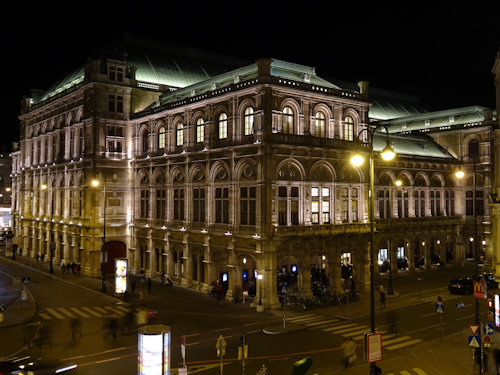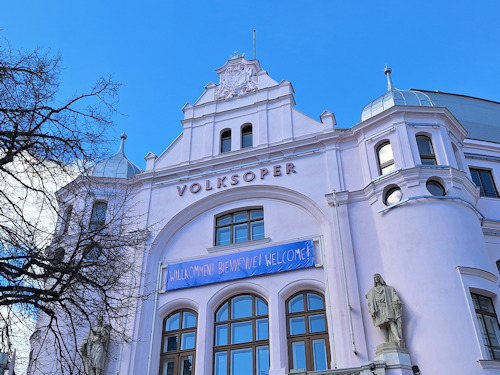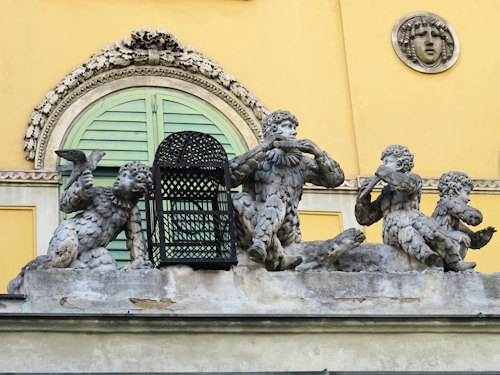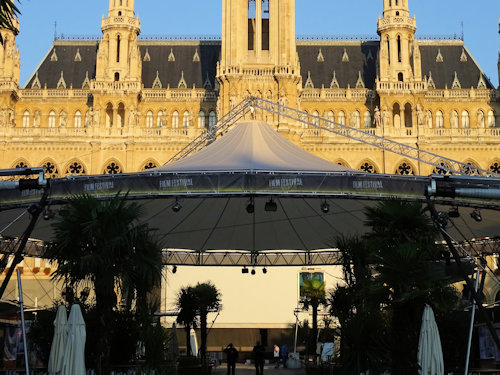
Various popular opera composers called Vienna home, so it’s no surprise to find one of the world’s most prestigious opera venues here as well.
- The famous Staatsoper opened in 1869
- …and Vienna has two other opera houses
- Egalitarian tradition means opera is priced for everyone
- Book a concert experience* for your trip
- See also:
The opera houses
Let us begin with the magnificence that is…
The Staatsoper

(The Staatsoper at night)
The Staatsoper (State Opera House) appeared in 1869 and enjoys an outstanding global reputation. Experts speak of it in the same breath as such institutions as the Paris Opera or New York’s The Met.
The house on Vienna’s Ringstrassen boulevard has the biggest budget and the best-looking building of the city’s opera venues, and it hosts — surprise! — mainly operatic productions with some ballet.
Iconic names like Luciano Pavarotti, Maria Callas, Enrico Caruso, and Tom Cruise have all performed here.
Sorry…Tom Cruise? Yep…the Staatsoper made an excellent film set for a Mission Impossible movie.
The downside to this glorious history and reputation is that the Staatsoper often sells out. However, you have an entirely plausible way to get inexpensive tickets on the day of a performance.
Should you simply wish to see inside this historical building, you don’t need a ticket for an opera. The Staatsoper offers rather lovely guided tours in various languages.
Season: September to June or early July
Address: Opernring 2, 1010 Vienna
Next up in our operatic tour is…
The Volksoper

(The main entrance)
Like the Staatsoper, the Volksoper (opened 1898) has its own ensemble, so can also vary its schedule frequently. It hosts opera, operettas, ballet and musicals; you might catch La Traviata one day and Carousel the next.
The Staatsoper actually moved here temporarily when WWII bombing heavily damaged their building.
The Volksoper also enjoys its own movie claim to fame, having featured in the Bond film, The Living Daylights.
Tip: I recently discovered the nearby Café Schopenhauer at Staudgasse 1, which is a strong option for refreshment before and/or after a performance.
Season: September to June
Address: Währinger Straße 78, 1090 Vienna
The Theater an der Wien

(Scene from the Magic Flute at the Papagenotor of the Theater an der Wien)
The Theater an der Wien tends to host short-run guest productions and only returned this century to the role of opera house, though it has a long and honourable operatic and musical history that predates even the Staatsoper.
Beethoven’s Fidelio premiered here, for example, in 1805. As did Johann Strauss II’s Die Fledermaus in 1874. So this venue has History with a capital H.
One or two of Vienna’s hidden delights surround the location. For example…
- Go around the side of the building to find the famous Papagenotor. This gateway with motifs from The Magic Flute pays tribute to Emanuel Schikaneder, who wrote the opera’s libretto and actually founded the theatre
- Cross over the road from the venue to the Naschmarkt, Vienna’s largest open-air market, full of international and gourmet delights, bars, and restaurants
- Go further up the road to see Otto Wagner’s Majolikahaus building(s) with their absolutely gorgeous facades
Season: September to June (note that the main house is closed for renovations until October 12th, 2024, but performances continue elsewhere)
Address: Linke Wienzeile 6, 1060 Vienna
Bonus: opera on film

(The screen with the Rathaus behind)
A huge annual event in Vienna is the open-air Rathaus Film Festival that runs across most of the summer. The screen and plenty of seating occupy space in front of the neogothic city hall, while a host of international food booths fill much of the rest of the square.
So what?
Well, the title “film festival” is a touch misleading. No “movies” here. Instead, evening showings present a musical performance of one kind or another.
Though many genres feature, the focus is on classical music. And operas always make up a significant part of the programme. The screenings are free: no ticket required.